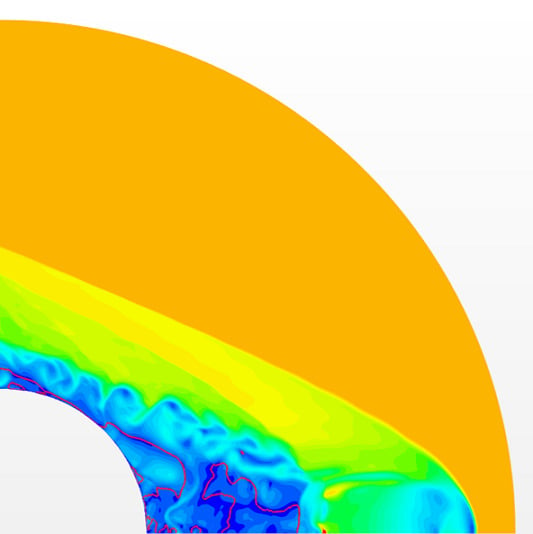Influence of Laser Energy Deposition Conditions on the Drag of A Sphere in Supersonic Flow
Abstract
:1. Introduction
2. Analysis Methods
2.1. Numerical Techniques
2.2. Validation of Applied Methods
2.2.1. Computational Domain and Flow Conditions
2.2.2. A Blast Wave Propagation and Its Interaction With a Shock Wave
3. Analysis of the Drag Reduction Ratio According to Various Energy Deposition Conditions
3.1. Comparison of the Drag Reduction Ratio for Single Deposition and Multiple Depositions
3.2. Effect of Deposition Frequency on the Drag Reduction Ratio
3.3. Effect of the Focal Distance on the Drag Reduction Ratio
3.4. Effect of the Deposition Energy on the Drag Reduction Ratio
4. Conclusions
Author Contributions
Funding
Acknowledgments
Conflicts of Interest
References
- Hinman, W.S.; Schmitt, S.; Johansen, C.T.; Rodi, P.E. Computational fluid dynamics study of optimized hypersonic leading edge geometries. In Proceedings of the 20th AIAA International Space Planes and Hypersonic Systems and Technologies Conference, Glasgow, UK, 6–9 July 2005. [Google Scholar]
- Kontogiannis, K.; Cerminara, A.; Taylor, N.; Soberster, A.; Sandham, N. Parametric geometry models for hypersonic aircraft components: Blunt leading edges. In Proceedings of the 20th AIAA International Space Planes and Hypersonic Systems and Technologies Conference, Glasgow, UK, 6–9 July 2005. [Google Scholar]
- Rodi, P. Optimization of Bezier curves for high speed leading edge geometries. In Proceedings of the 51st AIAA Aerospace Sciences Meeting including the New Horizons Forum and Aerospace Exposition, Grapevine, TX, USA, 7 January 2013. [Google Scholar]
- Stalder, J.R.; Nielsen, H.V. Heat Transfer from a Hemisphere-Cylinder Equipped with Flow-Separation Spikes; NACA TN 3287; National Advisory Committee for Aeronautics, Ames Aeronautical Lab.: Moffett Field, CA, USA, 1954.
- Bogdonoff, S.M.; Vas, I.E. Preliminary Investigations of Spiked Bodies at Hypersonic Speeds. J. Aero/Space Sci. 1959, 26, 65–74. [Google Scholar] [CrossRef]
- Crawford, D.H. Investigation of the Flow Over a Spiked-Nose Hemisphere-Cylinder at a Mach Number of 6.8; NASA TN D-118; National Aeronautics and Space Administration: Washington, DC, USA, 1959.
- Reding, J.P.; Guenther, R.A.; Richter, B.J. Unsteady Aerodynamic Considerations in the Design of a Drag-Reduction Spike. J. Spacecr. Rocket. 1977, 14, 54–60. [Google Scholar] [CrossRef]
- Adelgren, R.G.; Yan, H.; Elliott, G.S.; Knight, D.; Beutner, T.J.; Zheltovodov, A.A. Control of Edney IV Interaction by Pulsed Laser Energy Deposition. AIAA J. 2005, 43, 256–269. [Google Scholar] [CrossRef]
- Adelgren, R.G.; Elliott, G.S.; Knight, D.; Zheltovodov, A.A.; Beutner, T.J. Energy deposition in supersonic cavity flow. In Proceedings of the 42nd AIAA Aerospace Sciences Meeting and Exhibit, Reno, NV, USA, 5–8 January 2004. [Google Scholar]
- Adelgren, R.G.; Yan, H.; Elliott, G.S.; Knight, D.; Zheltovodov, A.A.; Ivanov, M. Localized flow control by laser energy deposition applied to Edney IV and intersecting shocks. In Proceedings of the 41st Aerospace Sciences Meeting and Exhibit, Reno, NV, USA, 6–9 January 2003. [Google Scholar]
- Yanji, H.; Diankai, W.; Qian, L.; Jifie, Y. Interaction of single-pulse laser energy with bow shock in hypersonic flow. Chin. J. Aeronaut. 2014, 27, 241–247. [Google Scholar] [Green Version]
- Lashkov, V.A.; Mashek, I.C.; Anisimov, Y.; Ivanov, V.; Kolesnichenko, Y.; Ryvkin, M.; Gorynya, A. Gas dynamic effect of microwave discharge on supersonic cone-shaped bodies. In Proceedings of the 42nd AIAA Aerospace Sciences Meeting and Exhibit, Reno, NV, USA, 5–8 January 2004. [Google Scholar]
- Lashkov, V.A.; Karpenko, A.G.; Khoronzhuk, R.S.; Mashek, I.C. Effect of Mach number on the efficiency of microwave energy deposition in supersonic flow. Phys. Plasmas 2016, 23, 1–6. [Google Scholar] [CrossRef]
- Azarova, O.A.; Knight, D.D.; Kolesnichenko, Y. Pulsating stochastic flows accompanying microwave filament/supersonic shock layer interaction. Shock Waves 2011, 21, 439–450. [Google Scholar] [CrossRef]
- Kolesnichenko, Y.; Brovkin, V.; Azarova, O.A.; Grudnitsky, V.; Lashkov, V.; Mashek, I. Microwave energy release regimes for drag reduction in supersonic flows. In Proceedings of the 40th AIAA Aerospace Sciences Meeting and Exhibit, Reno, NV, USA, 14–17 January 2002. [Google Scholar]
- Liu, F.; Yan, H.; Zheltovodov, A. Effect of pulsed periodic energy deposition on mixing of supersonic flow interaction with oblique shock. In Proceedings of the 2018 AIAA Aerospace Sciences Meeting, Kissimmee, FL, USA, 8–12 January 2018. [Google Scholar]
- Zheltovodov, A.A.; Pimonov, E.A.; Knight, D.D. Energy Deposition Influence on Supersonic Flow Over Axisymmetric Bodies. In Proceedings of the 45th AIAA Aerospace Sciences Meeting and Exhibit, Reno, NV, USA, 8 January 2007. [Google Scholar]
- Iwakawa, A.; Shoda, T.; Majama, R.; Pham, H.S.; Sasoh, A. Mach Number Effect on Supersonic Drag Reduction using Repetitive Laser Energy Depositions over a Blunt Body. Trans. Jpn. Soc. Aeronaut. Space Sci. 2017, 60, 303–311. [Google Scholar] [CrossRef] [Green Version]
- Azarova, O.A.; Knight, D.D. Numerical prediction of dynamics of interaction of laser discharge plasma with a hemisphere–cylinder in a supersonic flow. In Proceedings of the 53rd AIAA Aerospace Sciences Meeting, Kissimmee, FL, USA, 5–9 January 2015. [Google Scholar]
- Azarova, O.A.; Knight, D.D. Interaction of microwave and laser discharge resulting heat spots with supersonic combined cylinder bodies. Aerosp. Sci. Technol. 2015, 43, 343–349. [Google Scholar] [CrossRef]
- Azarova, O.A.; Knight, D.D. An approach of drag force decrease for combined cylinder AD bodies under the action of microwave and laser energy deposition. Aerosp. Sci. Technol. 2017, 64, 154–160. [Google Scholar] [CrossRef]
- Pham, H.S.; Shoda, T.; Tamba, T.; Iwakawa, A.; Sasoh, A. Impacts of Laser Energy Deposition on Flow Instability over Double-Cone Model. AIAA J. 2017, 55, 2992–3000. [Google Scholar] [CrossRef]
- Pham, H.S.; Myokan, M.; Tamba, T.; Iwakawa, A.; Sasoh, A. Impacts of Energy Deposition on Flow Characteristics over an Inlet. In Proceedings of the 47th AIAA Fluid Dynamics Conference, Denver, CO, USA, 5–9 June 2017. [Google Scholar]
- Pehlivanoglu, Y.V. An optimization of energy addition to suppress the coalescence of the shock waves. Aerosp. Sci. Technol. 2013, 25, 75–83. [Google Scholar] [CrossRef]
- Elias, P.; Severac, N.; Luyssen, J.; Tobeli, J.; Lambert, F.; Bur, R.; Houard, A.; Andre, Y.; Albert, S.; Mysyrowicz, A.; et al. Experimental Investigation of Linear Energy Deposition Using Femtosecond Laser Filamentation in a M = 3 Supersonic Flow. In Proceedings of the 2018 Joint Propulsion Conference, Cincinnati, OH, USA, 9–11 July 2018. [Google Scholar]
- Liu, H.; Yan, C.; Zhao, Y.; Wang, S. Active control method for restart performances of hypersonic inlets based on energy addition. Aerosp. Sci. Technol. 2019, 85, 481–494. [Google Scholar] [CrossRef]
- Pham, H.S.; Myokan, M.; Tamba, T.; Iwakawa, A.; Sasoh, A. Effects of Repetitive Laser Energy Deposition on Supersonic Duct Flows. AIAA J. 2018, 56, 542–553. [Google Scholar] [CrossRef]
- Sasoh, A.; Kim, J.H.; Yamashita, K.; Sakai, T. Supersonic aerodynamic performance of truncated cones with repetitive laser pulse energy depositions. Shock Waves 2014, 24, 59–67. [Google Scholar] [CrossRef]
- Mortazavi, M.; Knight, D. Numerical simulation of energy deposition in a viscous supersonic flow past a hemisphere. In Proceedings of the 53rd Aerospace Sciences Meeting, Kissimmee, FL, USA, 5–9 January 2015. [Google Scholar]
- Mortazavi, M.; Knight, D. Numerical simulation of energy deposition in a supersonic flow past a hemisphere. In Proceedings of the 52nd Aerospace Sciences Meeting and Exhibit, National Harbor, MD, USA, 13–17 January 2015. [Google Scholar]
- Ghosh, S.; Mahesh, K. Numerical simulation of the fluid dynamic effects of laser energy deposition in air. J. Fluid Mech. 2008, 605, 329–354. [Google Scholar] [CrossRef] [Green Version]
- Leela, C.; Bagchi, S.; Kumar, V.R.; Tewari, S.P.; Kiran, P.P. Dynamics of Laser Induced Micro-Shock Waves and Hot Core Plasma in Quiescent Air. Laser Part Beams 2013, 31, 263–272. [Google Scholar] [CrossRef]
- Georgievskii, P.Y.; Levin, V.A. Unsteady interaction of a sphere with atmospheric temperature inhomogeneity at supersonic speed. Fluid Dyn. 1993, 28, 568–574. [Google Scholar] [CrossRef]
- Sangtabi, A.R.; Ramiar, A.; Ranjbar, A.A.; Abdollahzadeh, M.; Kianifar, A. Influence of repetitive laser pulse energy depositions on supersonic flow over a sphere, cone and oblate spheroid. Aerosp. Sci. Technol. 2018, 76, 72–81. [Google Scholar] [CrossRef]


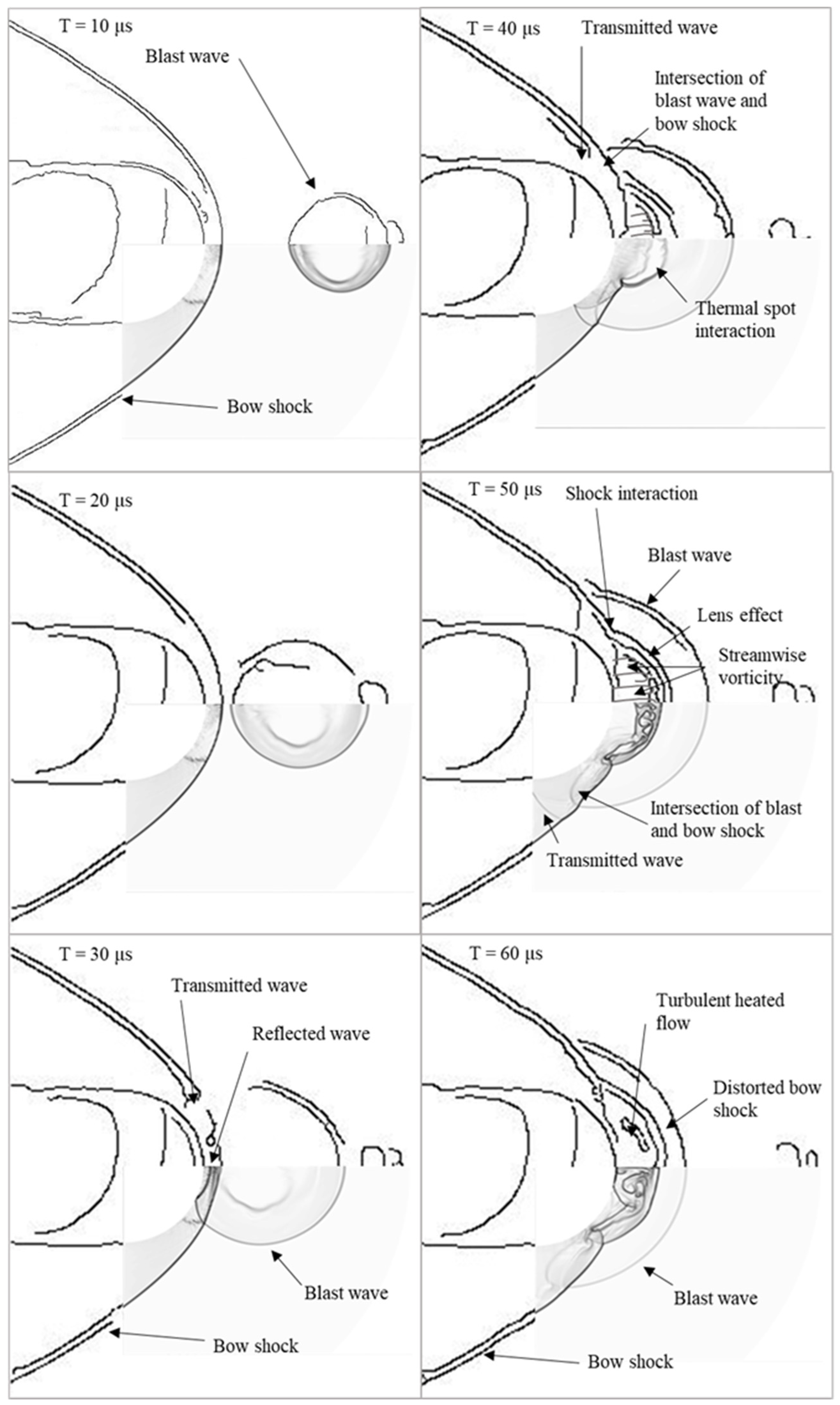
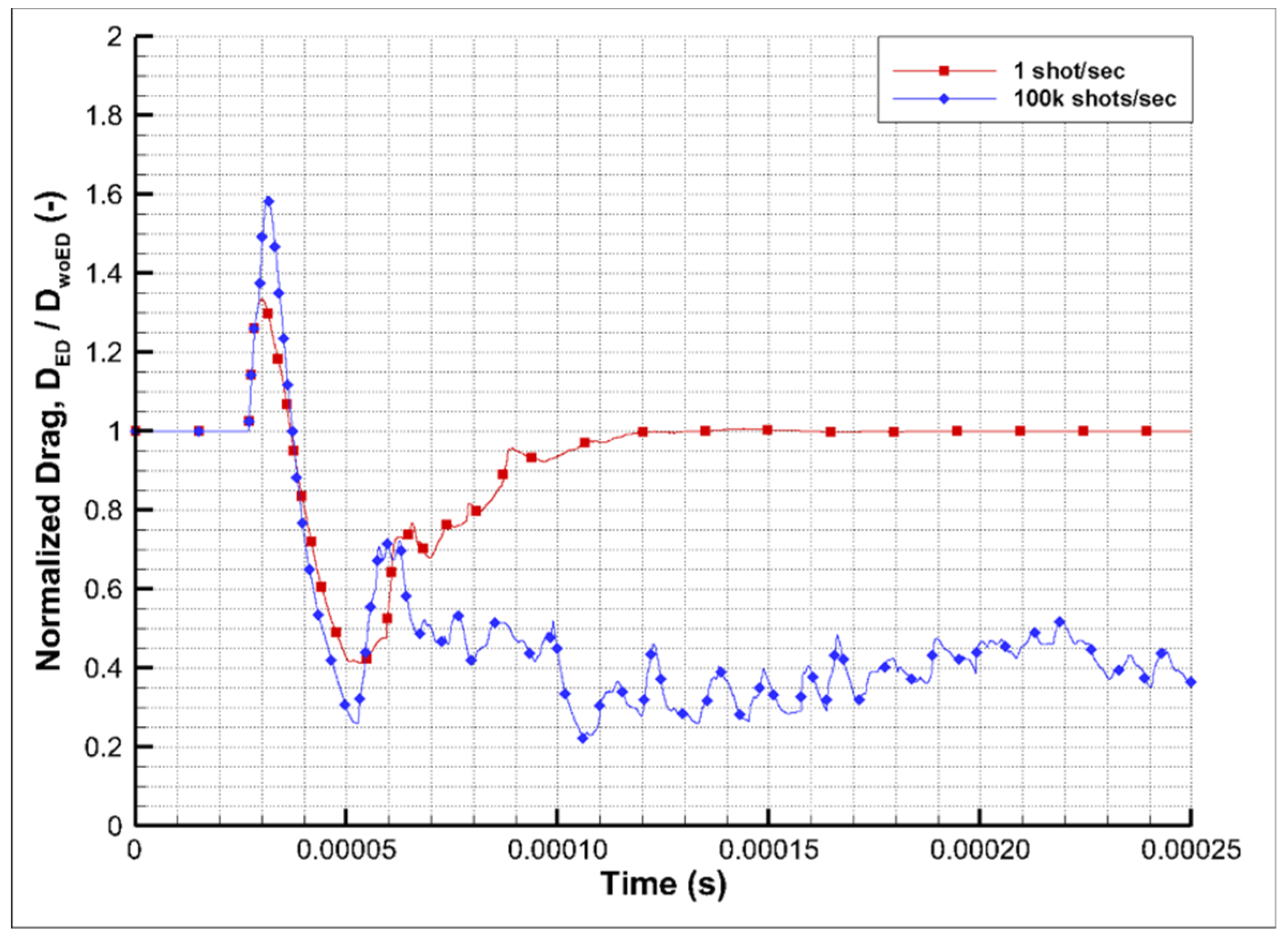


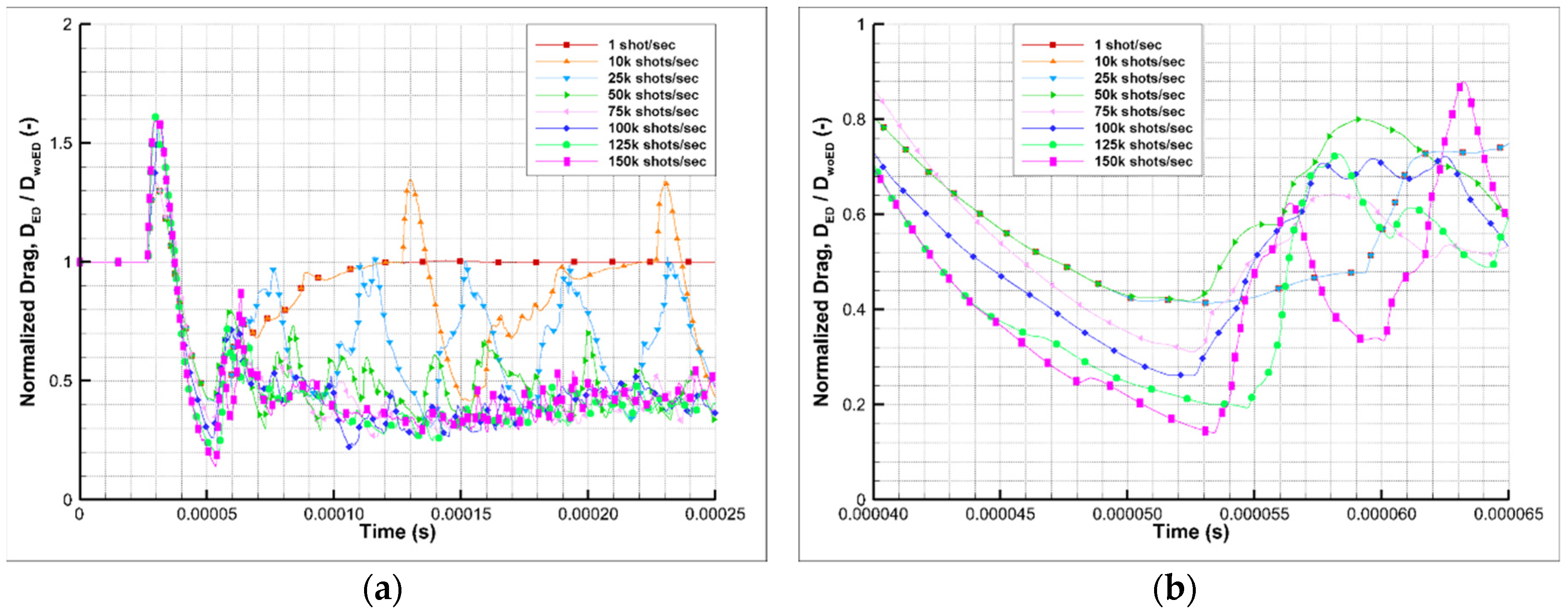
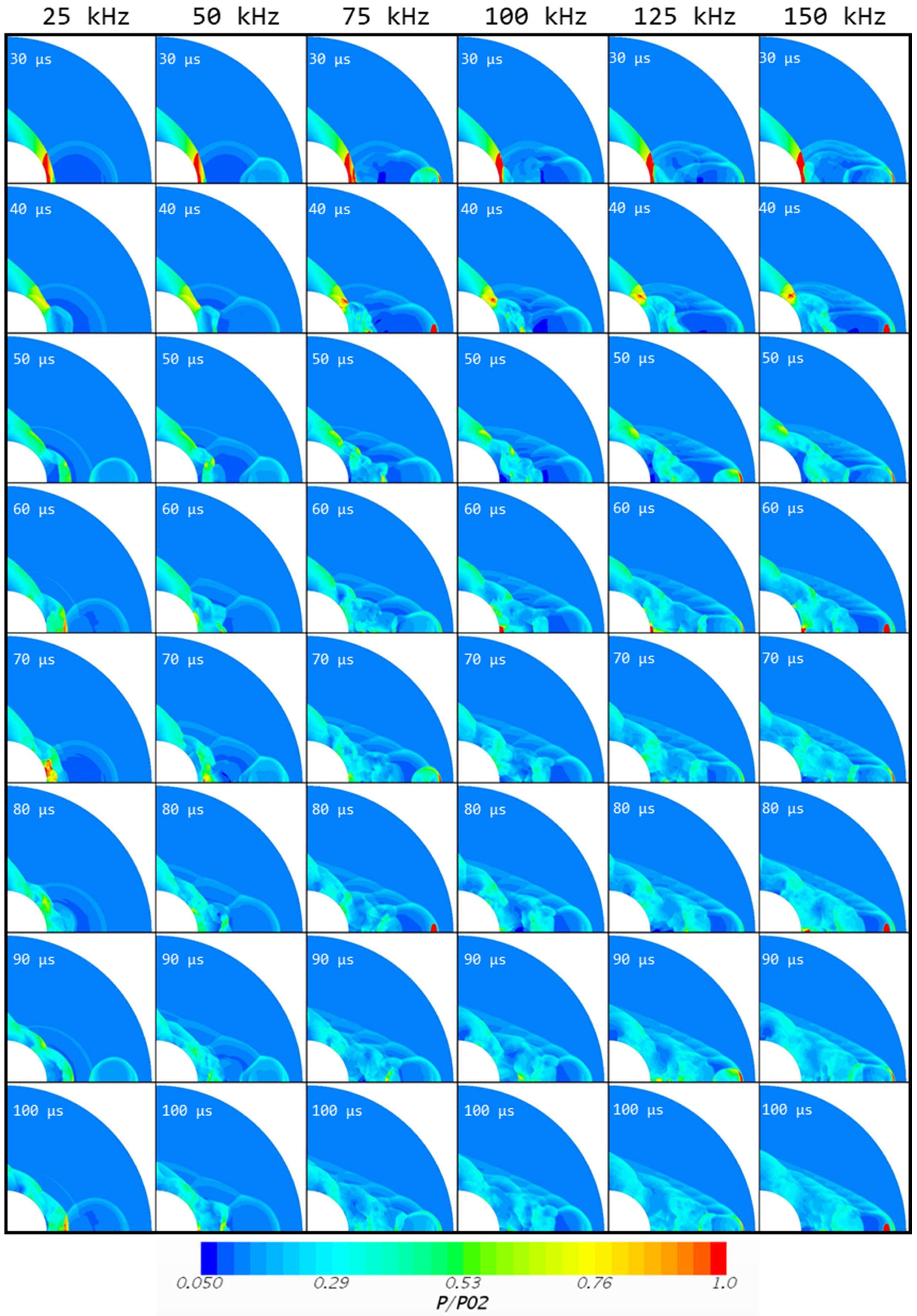
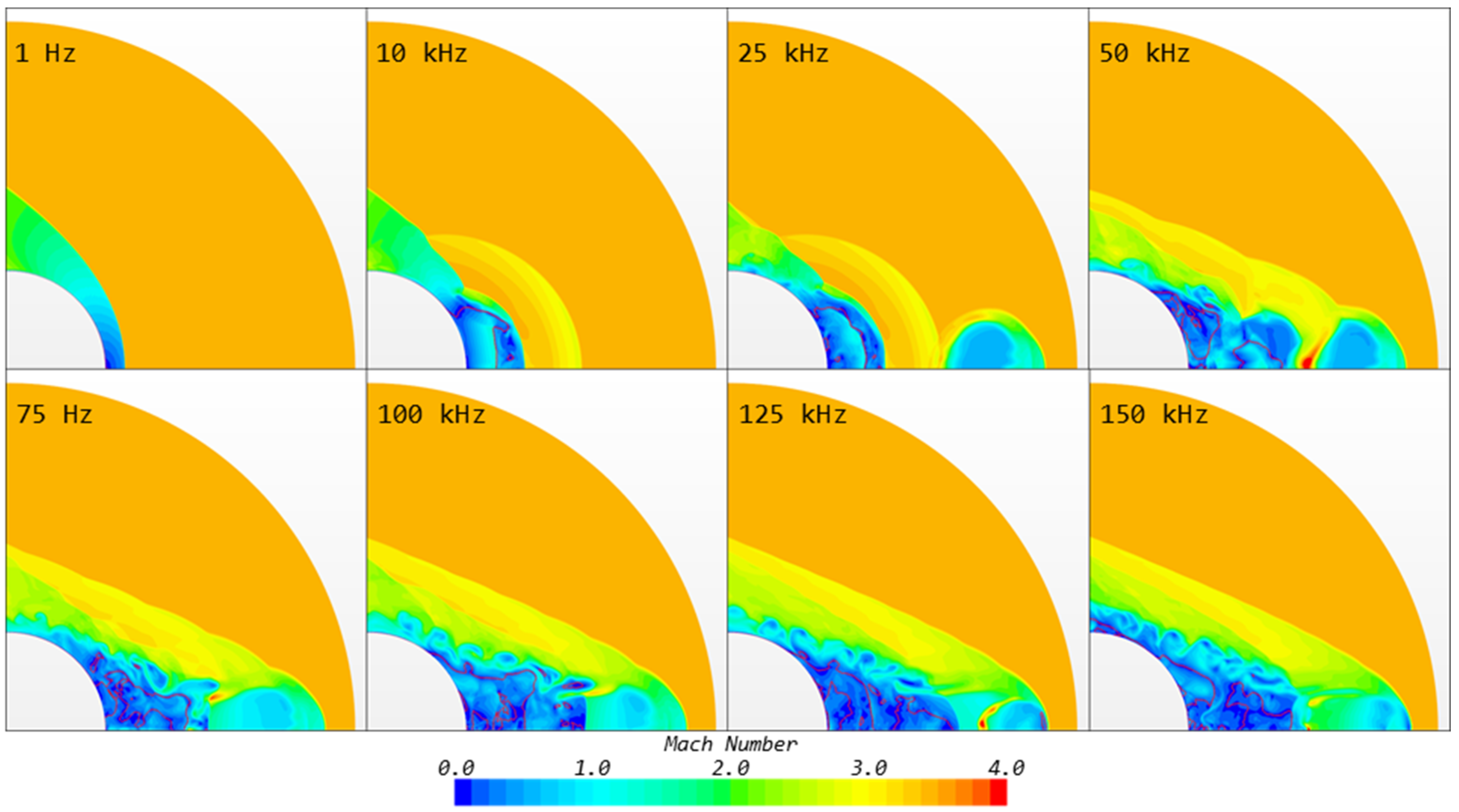

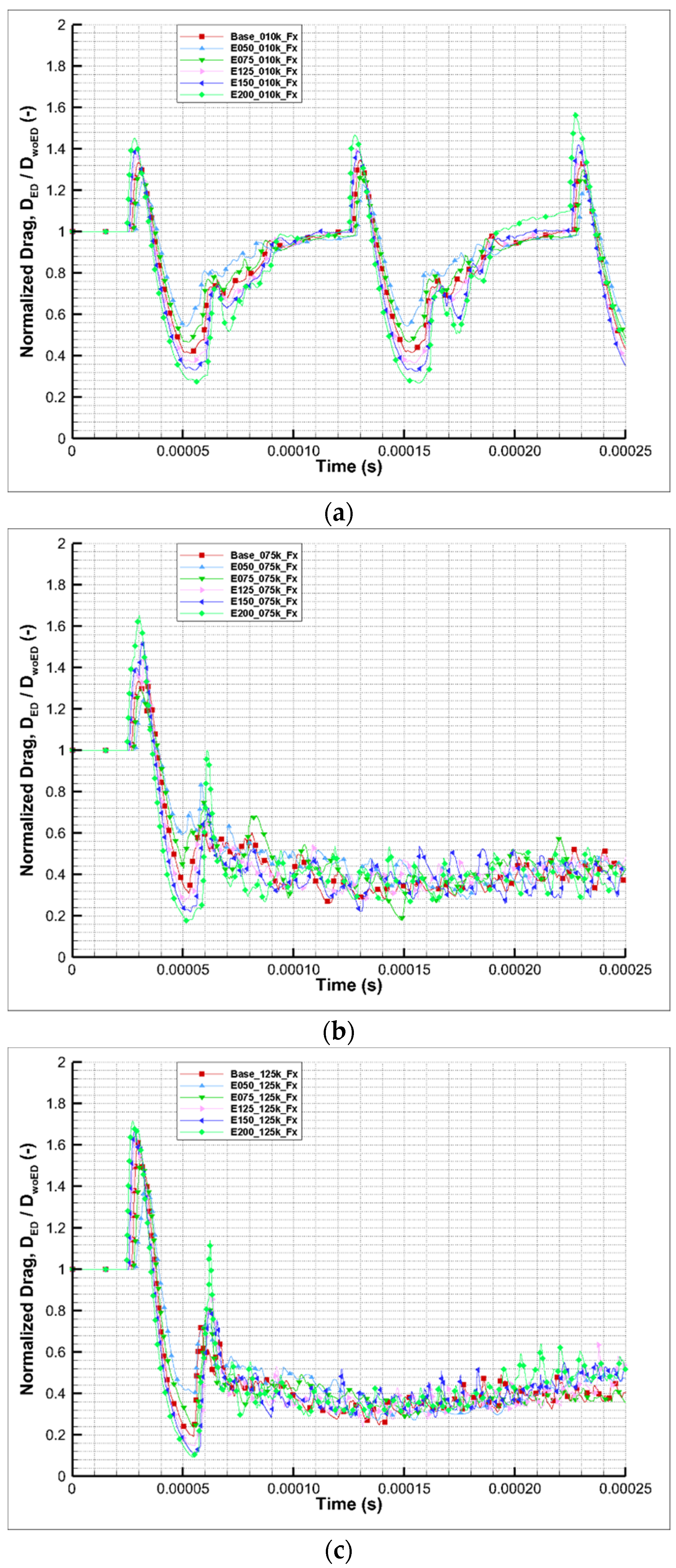
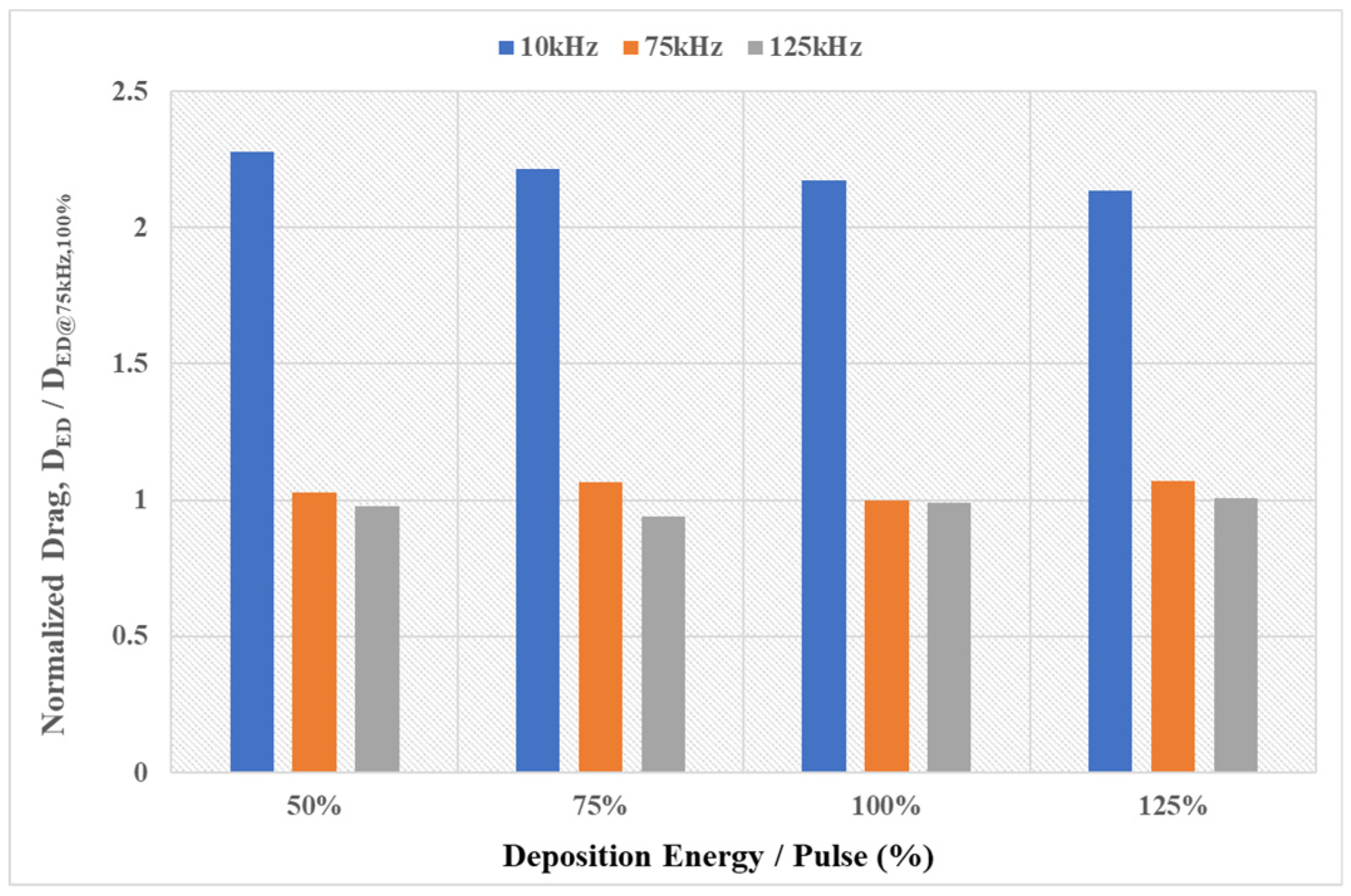
| Mach number | 3.45 |
| Static temperature (K) | 77.8 |
| Static pressure (Pa) | 1.31 × 104 |
| Sphere diameter (m) | 2.54 × 10−2 |
| Deposition distance at center line (m) | 2.54 × 10−2 |
| Grid Types | Nx | |
|---|---|---|
| G1 | 321 | 0.262 |
| G2 | 455 | 0.100 |
| G3 | 645 | 0.003 |
| G4 | 911 | - |
© 2019 by the authors. Licensee MDPI, Basel, Switzerland. This article is an open access article distributed under the terms and conditions of the Creative Commons Attribution (CC BY) license (http://creativecommons.org/licenses/by/4.0/).
Share and Cite
Kim, S.; Lee, H.J. Influence of Laser Energy Deposition Conditions on the Drag of A Sphere in Supersonic Flow. Energies 2019, 12, 3914. https://doi.org/10.3390/en12203914
Kim S, Lee HJ. Influence of Laser Energy Deposition Conditions on the Drag of A Sphere in Supersonic Flow. Energies. 2019; 12(20):3914. https://doi.org/10.3390/en12203914
Chicago/Turabian StyleKim, Seihwan, and Hyoung Jin Lee. 2019. "Influence of Laser Energy Deposition Conditions on the Drag of A Sphere in Supersonic Flow" Energies 12, no. 20: 3914. https://doi.org/10.3390/en12203914



